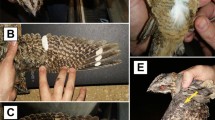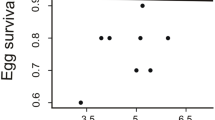Abstract
Plumage colouration serves a variety of functions for birds, including conspecific signalling, crypsis, and predator–prey interactions. Though much research has been conducted on colour changes in species with delayed plumage maturation, where birds do not exhibit definitive adult plumage until their second breeding season or later, relatively few studies have examined how plumage colour changes once definitive adult plumage has been attained. In this study on male and female American Redstarts (Setophaga ruticilla), which exhibit male delayed plumage maturation, we used reflectance spectrometry to evaluate carotenoid-based tail colour changes over 11 breeding seasons, examining both within-individual and population-level changes. At a population level, males in their first breeding season in definitive adult plumage had a feather hue that was more orange-shifted than birds in their second year in adult plumage, and marginally, but not significantly, more orange-shifted than birds in their third year in adult plumage. Within-individual analysis of males recaptured in subsequent seasons also revealed a shift away from orange towards a more yellow feather hue as individuals aged. Within individuals, red chroma was highest for males in their second year in adult plumage, but it showed no population-level effects. At the population level, female redstarts in their first breeding season displayed plumage with a higher red chroma and a lower brightness than birds in their second breeding season, potentially as a result of differences in the timing and conditions of moult (first-year bird tail feathers were grown in the nest). For adult males and females, there was no difference in plumage colouration between birds that returned to the study site compared to those that failed to return. Together, our results suggest that within-individual change rather than differential survival best explains our findings. We suggest that studies examining age-related colour changes are critical for understanding the evolution of complex signalling systems, such as that of American Redstarts.
Zusammenfassung
Altersabhängige Änderung im karotinoid-gefärbten Gefieder des Schnäpperwaldsängers Die Gefiederfärbung bei Vögeln dient verschiedensten Funktionen, darunter einer Signalfunktion für Artgenossen, der Tarnung und der Interaktion zwischen Räuber und Beute. Während es viele Untersuchungen gibt über den Farbwechsel bei Arten mit verzögerter Gefieder-Reifung, wenn Vögel ihr endgültiges Adult-Gefieder nicht vor der zweiten Brutsaison oder später aufweisen, gibt es relativ wenige Studien, die untersuchten, wie sich die Gefiederfärbung ändert, nachdem das endgültige Adult-Gefieder entwickelt ist. In dieser Studie über männliche und weibliche Schnäpperwaldsänger (Setophaga ruticilla), bei denen die Männchen eine verzögerte Gefieder-Reifung aufweisen, setzten wir die Reflexions-Photospektrometrie ein, um die Farbveränderung der karotinoid-gefärbten Schwanzfedern über 11 Brutzeiten zu untersuchen, und zwar sowohl intra-individuelle als auch populationsweite Veränderungen. Auf Populationsebene hatten Männchen in ihrer ersten Brutsaison im Adult-Gefieder einen Farbton der Federn, der mehr Richtung orange ging als Vögel im zweiten Jahr und etwas, aber nicht signifikant mehr Richtung orange gehend als Vögel im dritten Jahr des Adult-Gefieders. Intra-individuelle Analysen an wiedergefangenen Männchen in aufeinanderfolgenden Jahren zeigte mit zunehmendem Alter der Tiere auch eine Verschiebung des Farbtons der Federn weg von orange mehr Richtung gelb. Innerhalb der Individuen war die Farbintensität für rot am höchsten für Männchen im zweiten Jahr des Adult-Gefieders, zeigte aber keinen populationsweiten Effekt. Populationsweit zeigten weibliche Schnäpperwaldsänger in der ersten Brutsaison ein Gefieder mit höherer Farbintensität und geringerer Helligkeit für rot, verglichen mit Vögeln in ihrer zweiten Brutsaison, möglicherweise als ein Ergebnis von Zeitpunkt und äußeren Bedingungen der Mauser (die erstjährigen Schwanzfedern wachsen noch im Nest). Für sowohl Männchen als auch Weibchen gab es keinen Unterschied in der Gefiederfärbung zwischen Vögeln, die zum Untersuchungsort zurückkehrten und solchen, die nicht zurückkehrten. Insgesamt legen unsere Ergebnisse nahe, dass intra-individuelle Veränderungen unsere Beobachtungen besser erklären als eine Abhängigkeit von Überlebensraten. Wir regen an, dass die Untersuchung von altersabhängigen Farbveränderungen entscheidend sind für das Verständnis der Evolution komplexer Signalsysteme, wie das des Schnäpperwaldsängers.


Similar content being viewed by others
Explore related subjects
Discover the latest articles and news from researchers in related subjects, suggested using machine learning.References
Andersson S, Prager M, Johansson EIA (2007) Carotenoid content and reflectance of yellow and red nuptial plumages in Widowbirds (Euplectes spp.). Funct Ecol 21:272–281
Bitton PP, Dawson RD (2008) Age-related differences in plumage characteristics of male Tree Swallows Tachycineta bicolor: hue and brightness signal different aspects of individual quality. J Avian Biol 39:446–452
Bitton PP, Dawson RD, Ochs CL (2008) Plumage characteristics, reproductive investment and assortative mating in Tree Swallows Tachycineta bicolor. Behav Ecol Sociobiol 62:1543–1550
Brooks R, Kemp DJ (2001) Can older males deliver the good genes? Trends Ecol Evol 6:308–313
Brush AH (1990) Metabolism of carotenoid pigments in birds. FASEB J 4:2969–2977
Budden AE, Dickinson JL (2009) Signals of quality and age: the information content of multiple plumage ornaments in male Western Bluebirds Sialia mexicana. J Avian Biol 40:18–27
Delhey K, Kempenaers B (2006) Age differences in Blue Tit Parus caeruleus plumage colour: within-individual changes or colour biased survival? J Avian Biol 37:339–348
Dumbacher JP, Fleischer RC (2001) Phylogenetic evidence for colour pattern convergence in toxic pitohuis: Müllerian mimicry in birds? Proc R Soc Lond B 268:1971–1976
Edler AU, Friedl TWP (2012) Age-related variation in carotenoid-based plumage ornaments of male Red Bishops Euplectes orix. J Ornithol 153:413–420
Fitze PS, Tschirren B, Richner H (2003) Carotenoid-based colour expression is determined early in nestling life. Oecologia 137:148–152
Germain RR, Reudink MW, Marra PP, Ratcliffe LM (2010) Carotenoid-based male plumage predicts parental investment in the American Redstart. Wilson J Ornithol 122:318–325
Germain RR, Reudink MW, Marra PP, Boag PT, Ratcliffe LM (2012) Delayed maturation of multiple signals in a migratory songbird. Behav Ecol Sociobiol 66:419–431
Gochfeld M, Burger J (1984) Age difference in foraging behavior of the American Robin (Turdus migratorius). Behaviour 88:227–239
Grunst AS, Rotenberry JT, Grunst ML (2014) Age-dependent relationships between multiple sexual pigments and condition in males and females. Behav Ecol 25:276–287
Hawkins GL, Hill GE, Mercadante A (2012) Delayed plumage maturation and delayed reproductive investment in birds. Biol Rev 87:257–274
Hill GE (1992) Proximate basis of variation in carotenoid pigmentation in male House Finches. Auk 109:1–12
Hill GE (1996) Subadult plumage in the house finch and tests of models for the evolution of delayed plumage maturation. Auk 113:858–874
Hill GE (2006) Female mate choice for ornamental coloration. In: Hill GE, McGraw KJ (eds) Bird coloration, vol 2. Function and evolution. Harvard University Press, Cambridge, pp 137–200
Hill GE (2010) National Geographic bird coloration. National Geographic Society, Washington, DC
Hill GE (2011) Condition-dependent traits as signals of the functionality of vital cellular processes. Ecol Lett 14:625–634
Hill GE, Johnson JD (2012) The vitamin A-redox hypothesis: a biochemical basis for honest signaling via carotenoid pigmentation. Am Nat 180:E127–E150
Hill GE, Montgomerie R (1994) Plumage colour signals nutritional condition in the House Finch. Proc R Soc Lond B 258:47–52
Hill GE, Inouye CY, Montgomerie R (2002) Dietary carotenoids predict plumage colouration in wild House Finches. Proc R Soc Lond B 269:1119–1124
Hobson KA, Wassenaar LI, Bayne E (2004) Using isotopic variance to detect long-distance dispersal and philopatry in birds: an example with Ovenbirds and American Redstarts. Condor 106:732–743
Jennisons MD, Møller AP, Petrie M (2001) Sexually selected traits and adult survival: a meta-analysis. Q Rev Biol 76:3–36
Lemon RE, Perreault S, Lozano GA (1996) Breeding dispersion and site fidelity of American Redstarts (Setophaga ruticilla). Can J Zool 74:2238–2247
McGraw KJ, Hudon J, Hill GE, Parker RS (2005) A simple and inexpensive chemical test for behavioral ecologists to determine the presence of carotenoid pigments in animal tissues. Behav Ecol Sociobiol 57:391–397
Montgomerie R (2006) Analyzing colors. In: Hill GE, McGraw KJ (eds) Bird coloration, vol 1. Mechanisms and measurements. Harvard University Press, Cambridge, pp 90–147
Montgomerie R (2008) CLR, version 1.05. Queen’s University, Kingston. http://post.queensu.ca/~mont/color/analyze.html. Accessed 10 Feb 2013
Morrison ML, Slack RD, Shanley E Jr (1978) Age and foraging ability relationships of olivaceous cormorants. Wilson Bull 90:414–422
Mumme RL (2014) White tail spots and tail-flicking behavior enhance foraging performance in the Hooded Warbler. Auk 131:141–149
Mumme RL, Galatowitsch ML, Jabloński PG, Stawarczyk TM, Cygan JP (2006) Evolutionary significance of geographic variation in a plumage-based foraging adaptation: an experimental test in the Slate-throated Redstart (Myioborus miniatus). Evolution 60:1086–1097
Ocean Optics (2012) Homepage. http://www.oceanoptics.com/homepage.asp. Accessed 9 Dec 2012
Olsen VA, Owens IPF (1998) Costly sexual signals: are carotenoids rare, risky or required? Trends Ecol Evol 13:510–514
Osmond MM, Reudink MW, Germain RR, Nocera JJ, Boag PT, Ratcliffe LM (2013) Relationships between carotenoid-based female plumage and age, reproduction and mate color in the American Redstart (Setophaga ruticilla). Can J Zool 91:589–595
Pagani-Núñez E, Senar JC (2012) Changes in carotenoid-based plumage colour in relation to age in European Serins Serinus serinus. IBIS 154:155–160
Procter-Gray E, Holmes RT (1981) Adaptive significance of delayed attainment of plumage in male American Redstarts: tests of two hypotheses. Evolution 35:742–751
Prum RO (2010) The Lande–Kirkpatrick mechanism is the null model of evolution by intersexual selection: implications for meaning, honesty, and design in intersexual signals. Evolution 64:3085–3100
Pyle P (1997) Molt limits in North American passerines. N Am Bird Bander 22:49–90
R Core Team (2013) R: a language and environment for statistical computing. R Foundation for Statistical Computing, Vienna. http://www.R-project.org/. Accessed 1 June 2014
Reudink MW, Marra PP, Boag PT, Ratcliffe LM (2009a) Plumage coloration predicts paternity and polygyny in the American Redstart. Anim Behav 77:495–501
Reudink MW, Studds CE, Marra PP, Kyser TK, Ratcliffe LM (2009b) Plumage brightness predicts non-breeding season territory quality in a long-distance migratory songbird, the American Redstart Setophaga ruticilla. J Avian Biol 40:34–41
Reudink, MW, McKellar AE, Marini KLD, McArthur S, Marra PP, Ratcliffe LM (2015) Inter-annual variation in American redstart (Setophaga ruticilla) plumage colour is associated with rainfall and temperature during moult: an 11-year study. Oecologia. doi:10.1007/s00442-014-3167-4
Robinson SK, Holmes RT (1982) Foraging behavior of forest birds: the relationship among search tactics, diet, and habitat structure. Ecology 63:1918–1931
Saks L, McGraw K, Hõrak P (2003) How feather colour reflects its carotenoid content. Func Ecol 17:555–561
Santos ESA, Scheck D, Nakagawa S (2011) Dominance and plumage traits: meta-analysis and metaregression analysis. Anim Behav 82:3–19
Serra L, Griggio M, Licheri D, Pilastro A (2007) Moult speed constrains the expression of a carotenoid-based sexual ornament. J Evol Biol 20:2028–2034
Siefferman L, Hill GE (2005) Male Eastern Bluebirds trade future ornamentation for current reproductive investment. Biol Lett 1:208–211
Simpson KL (1983) Relative value of carotenoids as precursors of vitamin A. Proc Nutr Soc 42:7–17
Slagsvold T, Dale S, Kruszewicz A (1995) Predation favours cryptic colouration in breeding male Pied Flycatchers. Anim Behav 50:1109–1121
Smith JM (1979) Game theory and the evolution of behaviour. Proc R Soc Lond B 205:475–488
Studds CE, Kyser TK, Marra PP (2008) Natal dispersal driven by environmental conditions interacting across the annual cycle of a migratory bird. Proc Natl Acad Sci USA 105:2929–2933
Sturm L (1945) A study of the nesting activity of the American Redstart. Auk 62:189–206
Tonra CM, Marini KLD, Marra PP, Germain RR, Holberton RL, Reudink MW (2014) Color expression in experimentally regrown feathers of an overwintering migratory bird: implications for signaling and seasonal interactions. Ecol Evol 4:122–1232
Val E, Quesada J, Senar JC (2010) Age-related differences in carotenoid-based plumage colouration are due to within-individual changes in Great Tits (Parus major). Ardea 98:179–184
Acknowledgments
We thank R. Norris, K. Langin, R. Germain, and numerous field assistants for help collecting feathers throughout this study. We thank N. Flood for helpful comments on earlier drafts of this manuscript. Funding for this project was provided by the National Science Foundation (PPM), Natural Sciences and Engineering Research Council Discovery Grants (MWR and LMR), and a CUEF U-REAP award (KLDM).
Author information
Authors and Affiliations
Corresponding author
Additional information
Communicated by K. C. Klasing.
Rights and permissions
About this article
Cite this article
Marini, K.L.D., McKellar, A.E., Ratcliffe, L.M. et al. Age-related change in carotenoid-based plumage of the American Redstart (Setophaga ruticilla). J Ornithol 156, 783–793 (2015). https://doi.org/10.1007/s10336-015-1168-7
Received:
Revised:
Accepted:
Published:
Issue Date:
DOI: https://doi.org/10.1007/s10336-015-1168-7
Keywords
Profiles
- Matthew W. Reudink View author profile




